Recent drive ICs for stepping motors have been miniaturized. The amount of heat generation has been suppressed by the lowered ON-resistance as the characteristics of the switching elements (FETs) have improved. Various functions have also been added to drive ICs, so that they are easier to use.
This section explains the fundamental parts of stepping motor drive ICs.
Classification of motor driver circuits
A driver circuit is required to operate a stepping motor.
There are two types of motor drive: unipolar and bipolar, and two types of control method of current flowing through a motor: constant-voltage and constant-current.
The combinations include:
[A] Unipolar constant-voltage driver
[B] Bipolar constant-voltage driver
[C] Unipolar constant-current driver
[D] Bipolar constant-current driver
and so on.
In constant-voltage drivers [A] and [B] above, the current flowing through a motor [I] is determined by the resistance component [R] of a motor coil and the voltage [V] applied to a motor according to Ohm's Law. *1
Constant-voltage drivers [A] and [B] above have simple circuit configurations. However, the change of motor characteristics (torque, responsiveness, and heat generation) are not so simple since the current value is fixed. *2
In constant-current drivers [C] and [D] above, the motor current is easy to change, so the change of motor characteristics is relatively simple. *3 *4
Also, by increasing the voltage supplied to the motor, responsiveness at high speed is better than that of a constant-voltage driver.
The constant-current drivers [C] and [D] above are suitable to bring out stepping motor’s characteristics, so semiconductor manufacturers have been converting these drivers into their drive ICs.
*1 Besides the resistance component, there is an influence of the inductance component. At low speeds, however, the resistance component is dominant.
*2 To change the characteristics significantly, you need to change the motor itself or the drive voltage. You can make a minor characteristic change by adjusting the constant of a regeneration circuit.
*3 Characteristics can be changed by adjusting the current value. At that time, motor heat generation need to be considered.
*4 In the rated-current drive, a large current value is throttled to the required value. Therefore, you need to select the voltage or the coil resistance value so that more current to flow than the current required.
[Illustration] Unipolar drive and bipolar drive
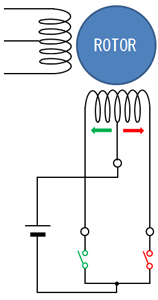 |
 |
| Unipolar | Bipolar |
| By using the coil in half, the polarity of a coil (N/S) is switched depending on which direction the current flows. ・Easy sequence with fewer switching elements. ・The efficiency of motor coil usage is low. |
By changing the direction of current flowing to a motor coil, the polarity of a coil (N/S) is switched. ・With many switching elements, the sequence is rather complicated. ・The efficiency of motor coil usage is high. |
[Illustration] Rated voltage drive and rated current drive
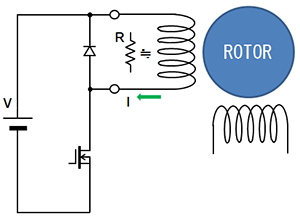 |
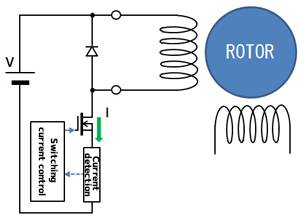 |
| Rated voltage drive | Rated current drive |
| The resistance component of a motor coil [R] and the motor-applying voltage [V] determine the motor current [I]. ・Circuit configuration is simple. ・The motor runs with its basic characteristics. Used for low-speed operations. |
Detects the current [I] flowing through a motor, and control the current to a constant value by a switching element. ・Circuit configuration is rather complicated. ・The characteristics of a motor will be improved. High speed operation can be allowed. |
Features of combination: [A] [B] [C] [D]
| [A] Unipolar constant voltage driver | [B] Bipolar constant voltage driver | [C] Unipolar constant current driver | [D] Bipolar constant-current driver |
 |
 |
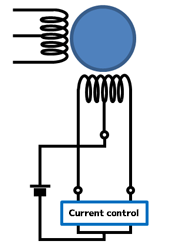 |
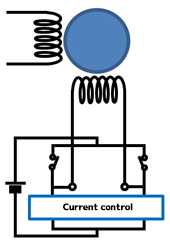 |
| ・Excitation control: Simple ・Coil usage: Half ・Circuit configuration: Simple ・Characteristic changeability: Difficult ・Motor characteristics: Basic ・Difficult to suppress heat generation while stopped |
・Excitation control: Rather complex ・Coil usage: Whole ・Circuit configuration: Slightly complex ・Characteristic changeability: Difficult ・Motor characteristics: Basic ・Difficult to suppress heat generation while stopped |
・Excitation control: Simple ・Coil usage: Half ・Circuit configuration: Complex ・Characteristic changeability: Simple ・Motor characteristics: Improved ・Possible to suppress heat generation while stopped |
・Excitation control: Rather complex ・Coil usage: Whole ・Circuit configuration: Complex ・Characteristic changeability: Simple ・Motor characteristics: Improved ・Possible to suppress heat generation while stopped |
| For low-cost applications that require fewer motor characteristics. [Features of operation] Low-speed operation |
Due to its complicated circuit configuration, not widely used in Japan. [Features of operation] Low-speed and medium-torque operation |
Circuit configuration and controllability are improved by the use of ICs. Effective use of motor characteristics. [Features of operation] High-speed and medium-torque operation |
Circuit configuration and controllability are improved by converting to ICs. Effective use of motor characteristics. [Features of operation] Medium-speed and high-torque operation |
* NPM’s driver lineup:
Unipolar constant-voltage driver [AD1111, AD1131]
Unipolar constant-current driver [AD1231]
Bipolar constant-current driver [AD1431]
INDEX
- 1. Fundamentals of stepping motor drive IC
- 2. Specification of the signal that gives operation commands to a drive IC
- 3. Drive IC control method "Excitation mode"
- 4. Decay control
- 5. Current setting when using constant-current drive ICs
- 6. How to select a motor to drive with a constant-current drive IC
- 7. Heat generation of a motor and a driver
- 8. Acceleration and deceleration of stepping motors
- 9. Malfunctions of stepping motors